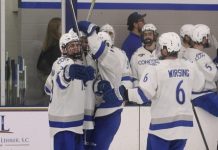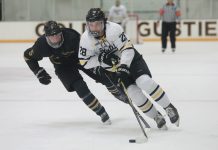Last year they finished dead last in Hockey East and missed the playoffs. Since beginning league play in 1989-90 they’ve languished in or near the cellar, finishing no higher than sixth. They have, hands down, the worst rink in the league, a true noose around their recruiting necks. And yet, voices heard in North Andover are waxing optimistic.
Has something funny gotten into the water, or are the Merrimack College Warriors poised for a big season?
Skeptics can be forgiven if they greet such thoughts with hoots of derision. After all, similar words were written about the 1995-96 squad, a team that was picked for fifth place in the league’s preseason poll but crashed and burned its way to last place after one close loss followed another. Finishing last in 1989-90 was expected, but finishing last in 1995-96 was a shock, depressing enough to test the mettle of even the most ardent Warriors fan.
Rumblings began that perhaps Merrimack should have never left the comfortable confines of Division II where the Warriors were proud owners of a national championship and seven ECAC Division II championships, including three straight prior to their entry into Hockey East.
To make matters even worse, the L.A. Kings recently lured captain and team MVP Steve McKenna away from his senior year with an offer he couldn’t refuse. At 6-foot-8 and 245 pounds, McKenna leaves a huge defensive and leadership void.
Other than that, Mrs. Lincoln, how did you like the play?
Surprisingly, the play could still have a happy ending. The first plot shift involves the best recruiting class since the move to Division I. Leading that class, at least in terms of fanfare, is Jayson Philbin.
Philbin tallied 111 career goals and 215 career assists while leading New England Prep school scoring the last two years at Cushing Academy. A self-described “smash-mouth” player, Philbin has all the makings of a fan favorite.
Of even greater long-term significance is that Philbin, who spurned UNH in his selection, is the first marquee local player to choose Merrimack over more established programs.
Additionally, forward Chris Halecki of Andover and Tabor Academy (29-36-65 in his senior year) also chose the Warriors over a Hockey East rival, in this case Northeastern. If Merrimack recruiters can turn this into a trend, most probably involving other talented prospects at Cushing, then the program will indeed have turned the recruiting corner.
Another recruit, Sandy Cohen, has been overshadowed by the arrival of local legend Philbin, but could reverse that equation next season. Cohen played for the Sioux City Musketeers this past season in the United States Hockey League (USHL). Although his 27-27–54 point totals in 42 regular season games were among the league leaders, what has really opened eyes is the way he was able to take his game to another level in the postseason.
In the USHL playoffs he talled 10-10-20 in nine games, as ninth place Sioux City pulled a first round upset and gave eventual champ Green Bay all it could handle in the semis. Cohen then upped the ante by leading the Musketeers to a second place finish in the US Junior A Hockey National Championship Tournament, scoring seven goals and five assists in three round robin games, including a tournament record five goals in an 8-6 win over American Frontier Hockey League champion Billings, Mont. Cohen could be just the sniper that the Warriors have lacked since Jim Vesey notched 40 goals in 1987-8.
Two other recruits, goaltender Cris Classen and defenseman Andrew Fox, could also fill important roles.
Although the team appears well established in goal with Martin Legault and Eric Thibeault, Classen has some predicting that he’ll be pushing the upperclassmen for time in the nets before the season is over.
Fox, a defenseman from the Saskatchewan Junior Hockey League (SJHL), compiled some fine offensive statistics (13-31-44 in 64 games) and was named his team’s MVP and won its “Outstanding Ability and Gentlemanly Conduct” award.
Ironically, Fox (62 PIM in 64 games) will be replacing Tom Costa (400 career PIM in 127 games) on the blueline, almost certainly resulting in fewer shorthanded and 4-on-4 situations.
Objectively, Merrimack’s recruiting class still lags behind those of some other Hockey East schools.
Boston College’s signings of Jeff Farkas, Mike Mottau, and Blake Bellefeuille constitute the top recruiting class in the league and could propel the Eagles into a top three finish. Boston University, rarely a slouch in the recruiting department, signed blue-chipper Tom Poti early, added a potential Mike Pomichter clone in Dan Lacouture, and recently added 17-year old phenom Chris Heron, who could outshine them all before he’s done.
Overemphasizing that Merrimack’s recruits still fall short of BU’s and BC’s, however, misses the point. The Warriors may not be ready yet to fight toe-to-toe for recruits with league giants who sport numerous championships, rabid fans, and superior facilities. However, they may have reached at least parity with the next recruiting tier in the league, schools like UMass-Lowell, Providence College, and Northeastern.
If so, then Merrimack may have the talent to start winning their share of all the close games — they had a 4-14 record in games decided by two goals or less — that plagued them last year.
Ultimately, the future for Merrimack pivots on the rumored building of a new rink. UNH and UMass-Amherst have recently built state-of-the-art facilities, and by all accounts UMass-Lowell is not far behind. It would seem that no amount of hard work and salesmanship will be able to sustain effective recruiting of top athletes to a building that is a laughingstock compared to others around the league.
Although this issue seems far from decided, it could determine whether the strength of the 1996 recruits is a temporary blip in an otherwise flat line or the beginning of an upwards surge.
Although the incoming freshmen are receiving the lion’s share of attention, most teams live and die by the contributions of the upperclassmen. Last year’s juniors formed the core of the team and although McKenna’s departure is a significant loss, the others should be expected to elevate their games as seniors. This is especially true in net.
Martin Legault was selected to the All-Hockey East team as a sophomore in 1994-95. Although his statistics this past year seemed to point to a comparable performance, Legault missed all but eight minutes against BU and Maine, two of the three top teams in the league. As a result, his deceptively solid stats were compiled against primarily weaker teams. The importance of Legault’s return to All-league form cannot be overstated.
John Jakopin, who moved to forward in midseason to team with Rob Beck and Martin Laroche on Merrimack’s top line, will likely return to the blueline in the wake of McKenna’s departure. Beck, who led the team in scoring with 16-19–35 overall totals, will need to add to those totals to compare with the top scorers around the league. Six other key seniors join Legault, Jakopin, and Beck to form the best group of upperclassmen in recent Merrimack history and could provide the experience that is often the difference during nailbiters.
Additionally, the junior year is one when many players emerge and Laroche (16-16-32), Gaetan Poirier (10-13-23), and Casey Kesselring (an injury-plagued 8-8-16) are already well along that path.
Laroche, who doubles as one of the team’s best defensive forwards, and Poirier made big strides in their sophomore seasons and together with Kesselring provide a lot of offensive potential.
Finally, defenseman Darryl Scoville was named to the All-Hockey East Rookie team, posting 6-19-25 point totals, a new record for Warrior freshman defensemen.
This talent base far exceeds that of the overmatched Merrimack squads that took the ice in the first few Warrior seasons in Hockey East, and is also superior to the improved, but still lacking, talent found on squads the last couple years. The 1989-90 squad received a rude awakening, being outscored 64-128 while posting a 3-18 league record. There were many problems specific to that inaugural season, ranging from huge losses to graduation to the foot-dragging by school trustees on the decision to join Hockey East, a delay that significantly damaged recruiting efforts.
However, by not not fielding a competitive squad that year, the school likely injected a ripple effect into downstream years as well. As recently as the 1992-93 season, Merrimack traveled to Maine and was pummeled 14-1 and then 11-2.
In the past couple years, however, the Warriors have progressed beyond those hapless predecessors. After the 1994-95 season, Martin Legault became the first Merrimack player selected to the All-Hockey East team. Additionally, the team has placed a player on the Hockey East All-Rookie team each year since 1993.
Three of those four players — Jakopin, Kesselring, and Scoville — return to the team next year. Although McKenna’s defection to the pros was an important loss, it also marked the third Warrior defensemen in the last calendar year to sign to play either in the upper minors (AHL or IHL) or with NHL teams.
Merrimack can no longer be considered a Hockey East punching bag bereft of talent. League superpower Boston University learned this first-hand the last two years, succumbing to the upstart Warriors 3-2 in January 1995 and again 7-4 in February 1996.
Clearly, in recent years the team has shed its early Hockey East roots of incompetence and progressed to its current state of good-but-not-quite-good- enough. Double-digit goal differentials have been replaced by one- and two- goal losses. Can the Warriors move to the next level?
It has been said that recruiting determines who wins the five-on-five battles, but that coaching can steal wins with the special teams. This may be yet another hoary, old chestnut that makes its way into the lexicon of hockey aficionados without necessarily being true. But if there is substance to the saying, then coach Ron Anderson and his staff could go a long way to translating the L’s into W’s by focusing more on the special teams.
Last year in Hockey East games only UMass-Amherst had a worse penalty killing record, while on the power play only BC and the Minutemen had worse totals. Unfortunately, this was not a single season fluke. The previous year, 1994-5, the Warriors had similarly lackluster special teams play, finishing sixth and seventh on the power play and penalty kill, respectively.
Coach Anderson enters the season in the final year of his contract. This could make him a convenient scapegoat for some fans and alumni. Frustrated Warrior followers, however, should recognize that Anderson has been dealt a meager hand, ranging from the substandard facilities to what seems like apathy from the college and its administration.
Anderson has been in a situation that few college coaches could have overcome. However, he may need to take responsibility for using improved special teams play to wring more wins out of the cards he’s been dealt. In particular, with a potential All-league goalie and a solid defense, it would seem inexcusable if Merrimack again finishes eighth out of nine teams in penalty killing.
A repeat performance will doom efforts to reach .500 and seriously challenge for playoff home ice.
Can the Warriors emerge from the ashes of the 1995-96 season? Several months remain before the dropping of the first puck, but the earliest signs are that they have a reasonable chance.
The blend of fresh new blood, experience, and optimism could combine to produce surprising results in North Andover. A good start may be of paramount importance, though, since fuses may be short following this past year. But if the team starts strong, the same skeptics who crowed “I told you so,” in 1995-96 may be rendered speechless.


